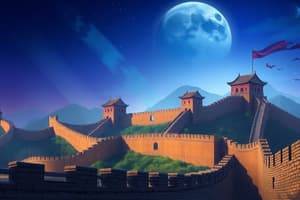Podcast
Questions and Answers
Who was the emperor responsible for building the Great Wall of China?
Who was the emperor responsible for building the Great Wall of China?
- Sun Tzu
- Emperor Wu
- Kublai Khan
- Qin Shihuang (correct)
What was the primary motivation behind the construction of the Great Wall of China?
What was the primary motivation behind the construction of the Great Wall of China?
- Promotion of art and culture
- Facilitating trade with the Roman Empire
- Creating a separation between China and Korea
- Protection against nomadic tribes from the northern plains (correct)
How long did it take to build the Great Wall of China?
How long did it take to build the Great Wall of China?
- 12 years (correct)
- 100 years
- 50 years
- 500 years
What purpose did the Great Wall of China serve during the Tang Dynasty?
What purpose did the Great Wall of China serve during the Tang Dynasty?
Which period saw a shift in the use of the Great Wall from defense to commerce and diplomacy?
Which period saw a shift in the use of the Great Wall from defense to commerce and diplomacy?
Who was responsible for the successful invasion of China, leading to the largest empire in history?
Who was responsible for the successful invasion of China, leading to the largest empire in history?
Which dynasty constructed the Ming Wall for defense against invasions?
Which dynasty constructed the Ming Wall for defense against invasions?
How did the downfall of the Ming Dynasty occur?
How did the downfall of the Ming Dynasty occur?
What event led to strained relations between China and Britain in the 18th century?
What event led to strained relations between China and Britain in the 18th century?
Which individual dedicated their life to documenting and protecting the Great Wall?
Which individual dedicated their life to documenting and protecting the Great Wall?
Flashcards are hidden until you start studying
Study Notes
- La Gran Muralla China es mil veces más larga que cualquier otro monumento jamás construido y se empezó a construir antes del nacimiento de Cristo.
- La construcción de la Gran Muralla estaba motivada por el temor a las hordas nómadas de las llanuras del norte que atacaban y aterrorizaban a los chinos.
- A lo largo de su historia, China ha construido varias murallas para protegerse de los invasores, como los hunos, mongoles y manchúes.
- La Gran Muralla fue edificada por el emperador Qin Shihuang, quien unificó China y creó un imperio poderoso pero tiránico.
- La muralla se construyó en tan solo 12 años, extendiéndose más de 6,400 km desde el centro de China hasta la frontera coreana.
- Se utilizaron técnicas como la compactación de tierra para construir la muralla de forma rápida y eficiente.
- La muralla ha resistido durante siglos a pesar de las duras condiciones climáticas y se cobró la vida de millones de trabajadores.
- Durante la dinastía Tang, la muralla dejó de usarse como defensa y se convirtió en una ruina mientras se enfocaban en el comercio y la diplomacia.
- La muralla sirvió para proteger las caravanas de la Ruta de la Seda, facilitando el comercio entre China y otros países.
- La historia de la muralla también involucra leyendas y eventos como la princesa Meng Jiangnu, las invasiones mongolas lideradas por Genghis Khan, y la resistencia frente a los pueblos bárbaros del norte.- A group of 10,000 Mongol warriors invaded China through a key pass north of Beijing, where they were initially stopped by a fortress gate with iron reinforcements placed by the Chinese to fend off the invasion.
- The Mongols, under Genghis Khan's successor Kublai Khan, later flanked the fortress through unguarded mountainous areas and successfully conquered China, ruling over the largest empire in history without needing a great wall for defense.
- The Ming Dynasty, determined to prevent future invasions, constructed the Ming Wall in 1368, a massive stone wall extending 6,400 kilometers from the Yellow Sea to the Gobi Desert, with numerous watchtowers for defense.
- Convicts were used as labor to build the Ming Wall, with drainage systems installed every 15 meters to prevent rainwater buildup inside the wall, and strategic design features like steep steps leading to watchtowers for defense against enemies.
- The Ming emperors fortified every inch of Chinese territory to prevent small enemy incursions at gates, maintaining a strong military presence along the wall for rapid response to threats.
- The Ming emperors resided in the Forbidden City in Beijing, surrounded by a moat and impressive walls, living a secluded life filled with elaborate rituals and guarded by concubines and eunuchs.
- The downfall of the Ming Dynasty came through the betrayal of a general who opened the Great Wall gates to let in Manchu invaders, leading to the end of the Ming rule in China.
- The Manchu rulers practiced a different diplomatic approach, receiving foreign delegations at their Summer Palace with strict tribute requirements, showcasing grandeur and wealth to visitors.
- Western interest in the Great Wall arose in the 18th century when Lord McCartney led a British diplomatic mission to China, refusing to perform traditional obeisance rituals and causing tension with the Chinese emperor.
- A British delegate's refusal to bow before the emperor led to strained relations and a message from the emperor rejecting British trade goods, highlighting a clash of imperial pride between China and Britain.
- Concerns about the preservation and historical significance of the Great Wall persist, with individuals like Chen Dalin dedicating their lives to documenting and protecting this ancient marvel, fearing its neglect and commercial exploitation.
Studying That Suits You
Use AI to generate personalized quizzes and flashcards to suit your learning preferences.





